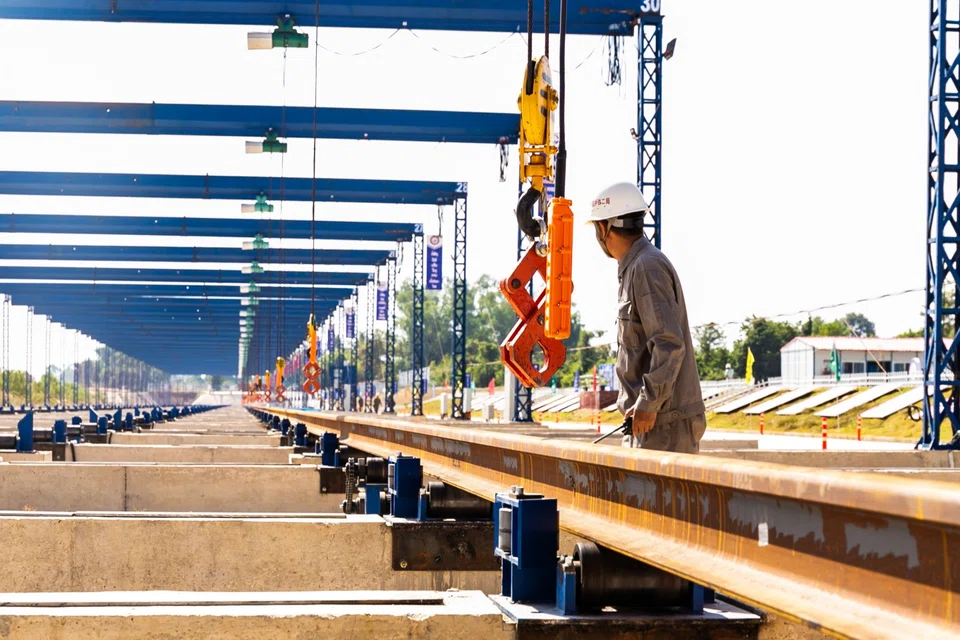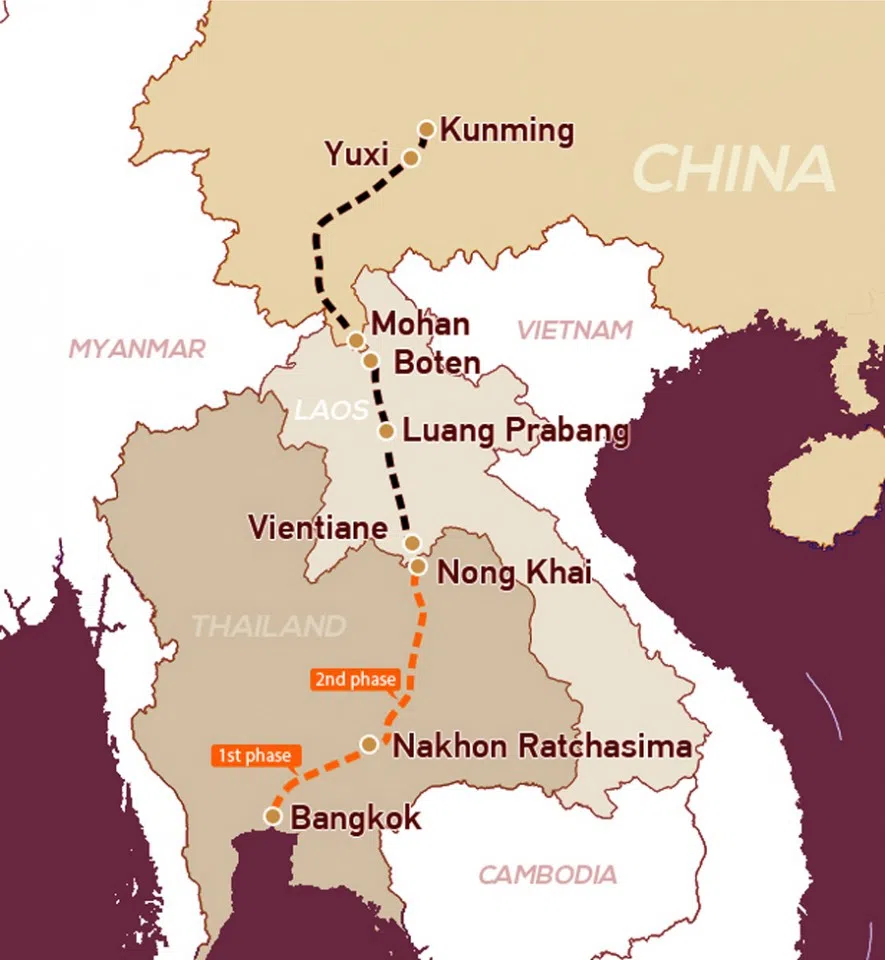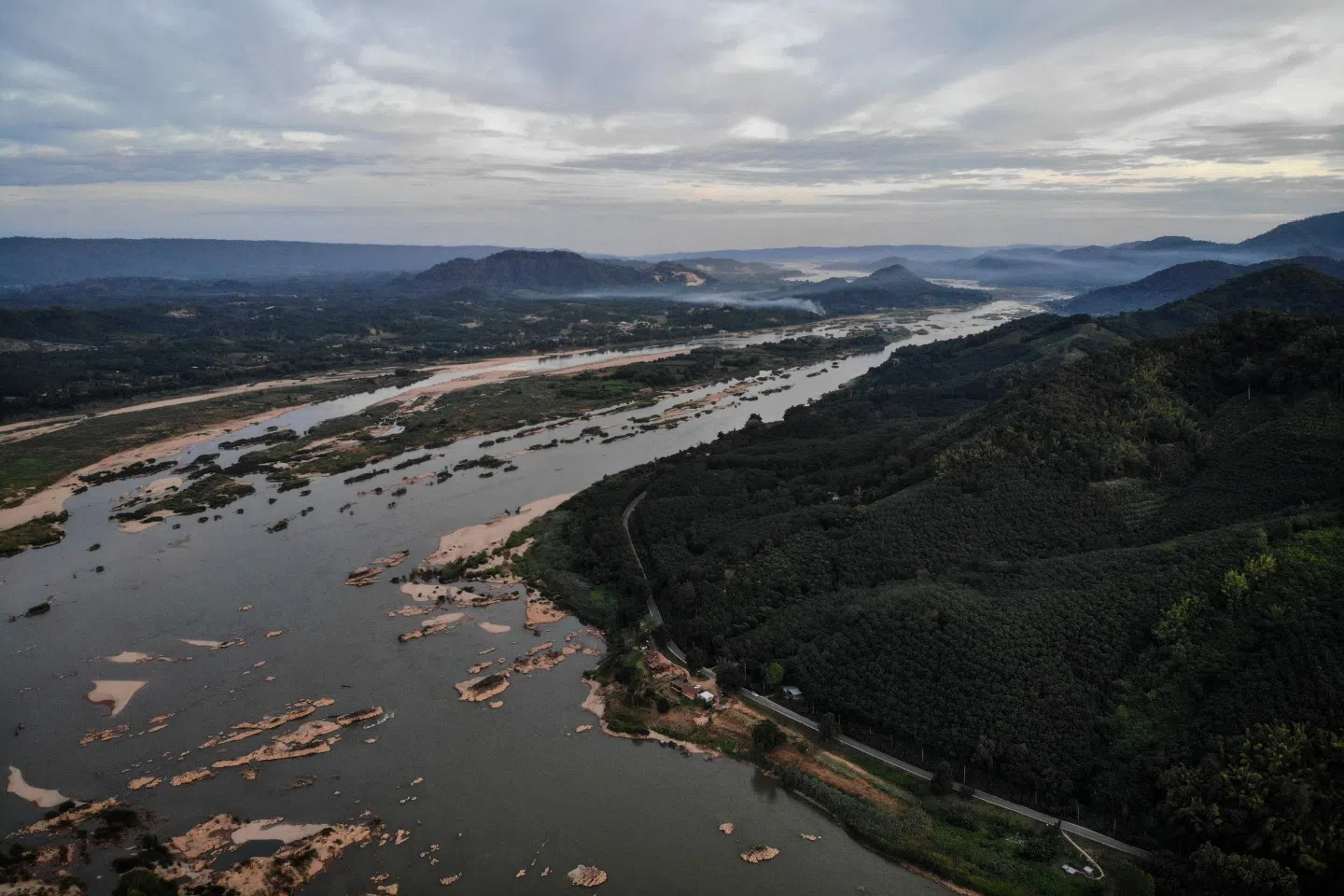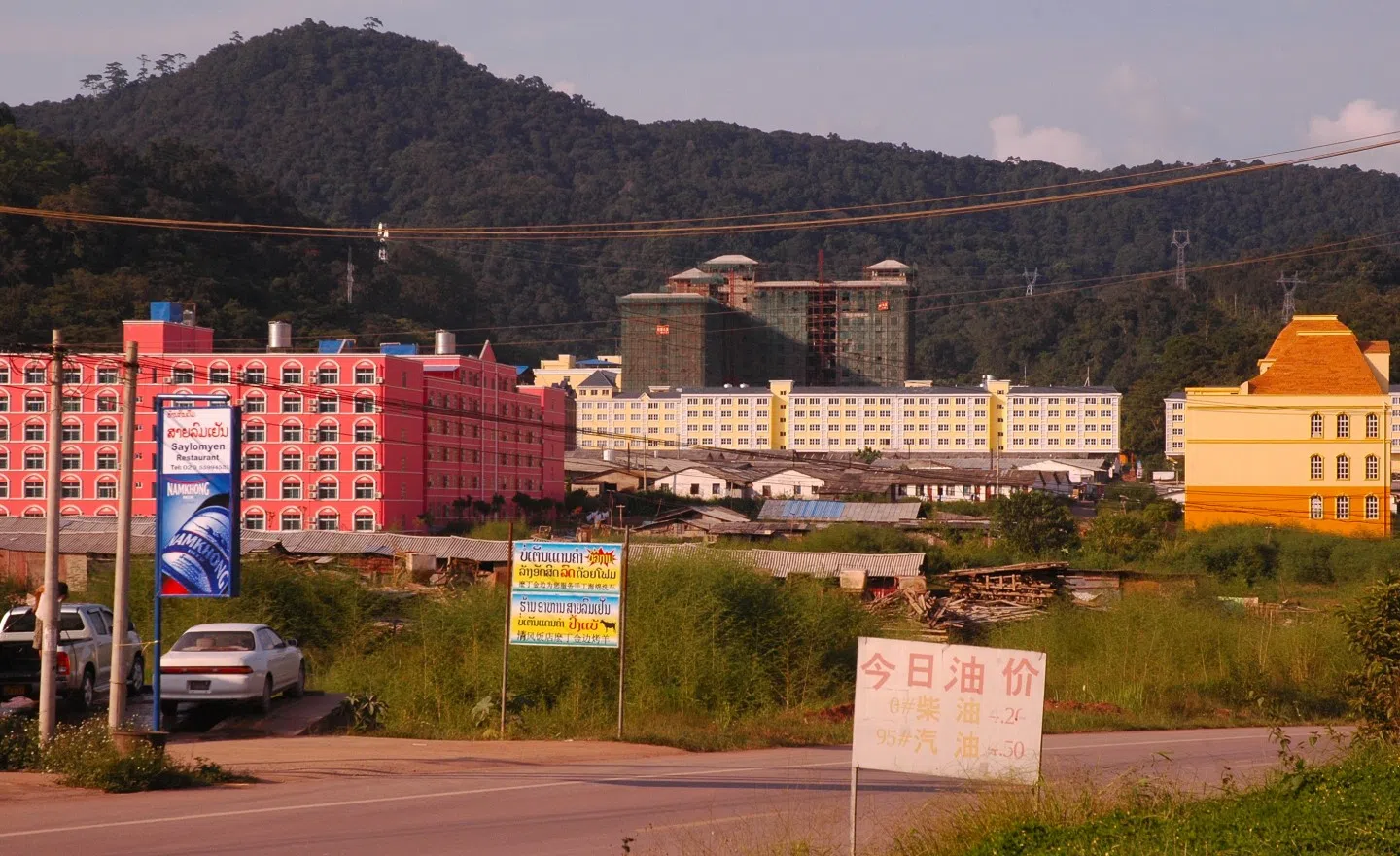Laos' high-speed railway coming round the bend
China's latest BRI railway project through Laos, connecting northern Thailand to China's southwestern province of Yunnan, has the potential to facilitate China's shipment of goods to the markets of mainland Southeast Asia. However, international attention is focused on the more than US$1.5 billion combined debt exposure that Laos has racked up for the railway project, with the prospect of national resources such as "underground mineral resources" being used as collateral for loan financing. Time will tell if the economic benefits for Laos will outweigh the costs.

Latest reports suggest that an ambitious high-speed electrified railway track running through Laos and connecting Kunming in China's southwestern province of Yunnan with northeastern Thailand is now 78% ready. All the bridges, tunnels and other structures have been completed; what remains to be done is to lay the track, and to install the signalling and the other "mechanics" necessary for operations. The first trains are expected to use the line approximately two years from now.
Formally announced in 2015, the railway is part of China's Belt and Road Initiative (BRI), and is widely seen as a major step in the Laotian government's long-held desire to turn the country from being land-locked to land-linked. For China, completion of the railway will not only link Yunnan directly to Thailand but also connect it to the Malaysian peninsula further south and ultimately to Singapore.

The 420-kilometre north-south line cuts through a large part of northern and central Laos, starting at Boten on the Laos-China border, passing through Luang Namtha province, then wending its way roughly south through Oudomxay, Luang Prabang and Vientiane provinces, before terminating at a station most likely to be built close to the country's capital, Vientiane. The precise location of the station is still not in the public domain, but it is expected to be somewhere south of the capital, and possibly close to a proposed new airport.
Its construction has been a colossal undertaking, requiring more than 70 tunnels and 150 bridges. Indeed, the line will run through tunnels for almost 200 kilometres. It will have ten stations in Laos, including one at the former royal capital of Luang Prabang. It will thus allow domestic passenger and freight use. The line will also have some 20 "crossing loops" to allow trains to pass each other on what will be largely a single-line railway.
This is not the first railway project in Laos. In the 1890s, the French built a small, seven- kilometre-long railway in the colony's southern panhandle, close to its border with Cambodia. The purpose of that line was essentially to allow for riverboat traffic further up the Mekong River and into Laos, despite the natural obstacle presented by the Khon waterfalls. Operation of that line halted in 1941, following Japanese occupation of French Indochina.
More recently, in 2008 and after years of discussions, the governments of Thailand and Laos agreed to build a three-kilometre-long railway across the Friendship Bridge - the first such bridge across the Mekong River - to connect Nong Khai on the Thai side to a station at Thanaleng on the Laotian side. The governments of Australia and Thailand funded the project. There had been expectations that the line would ultimately run a further 20 kilometres, to Vientiane itself, possibly with French funding, but this never transpired. The result is that a small passenger train runs a few times each way each day, requiring riders to get off at both ends to go through immigration checkpoints. There have also been vague plans to construct a 220-kilometre-long railway running roughly east-west through Laos's southern panhandle connecting northeastern Thailand with central Vietnam. A build and operate contract for this project was signed in late 2012, but it has not led to construction. There are, however, a privately owned "dry port", bonded warehouse and logistics hub in Savannakhet.

For China, the economic and geo-strategic attraction of the new high-speed railway is considerable. It will allow the shipment of goods from southern and south-western China to the markets of Mainland Southeast Asia, without having to depend on aviation or long shipping routes. As in the case of the proposed railway connecting Yunnan to Rakhine State on Myanmar's west coast, and thus to the Indian Ocean, the China-Laos railway will give China significantly greater transportation and logistical options in reaching markets and economies to its south and west.
It appears that the new railway will terminate at Vientiane, and not run on to the station at Thanaleng, though the latter could serve as a single trans-shipment point for cargo heading to and from Thailand. In either case, cargo will have to be trans-shipped at least once between Vientiane and Nong Khai, as the gauges of the new line and of that crossing the Friendship Bridge are different.
Seamless cargo traffic from Kunming to Bangkok will therefore not be possible, at least for some time, although it has been widely reported that the Thai government is also planning a high-speed railway to link Bangkok and Nong Khai, again with loans from China. If this project does go ahead, it will probably not be operational before 2026 at the earliest. For that matter, Malaysia's planned high-speed railway project, first announced in 2010 and meant to run down the peninsula to Singapore, is currently postponed, following the recent change in government. The principal reason for this postponement is Kuala Lumpur's concern over the elevated costs.
Economic concerns
The cost of the China-Laos railway project is probably the matter that has attracted the greatest international attention. That cost is around US$6 billion, of which 60% or US$3.5 billion is in the form of borrowing from the Export-Import Bank of China. A further 40%, amounting to US$2.4 billion, is being funded with equity in the form of a special purpose vehicle.
This concern is a joint venture company among three Chinese state-owned firms and one Laotian state-owned enterprise. The latter enterprise holds a 30% stake in the new concern. To fund that stake, the Laotian government has committed US$250 million from the national budget and taken a second loan of US$480 million from the Export-Import Bank of China. The country's combined debt exposure to that for the railway project is therefore more than US$1.5 billion. The loan terms are believed to be for 35 years, with a five-year grace period, and an interest rate of 2.3%. This is a considerable sum for a country with a nominal GDP of around US$20 billion, and official foreign exchange reserves of around US$1.1 billion. For the railway to make economic sense, the revenue that it generates will need to be sufficient to permit Laos to service these loans.
...some reports intimated that Laos would provide "underground mineral reserves" as collateral for the loan financing. Thus, if the revenues from the railway were not sufficient to service the debt, the lender would presumably have rights to mineral extraction as an alternative means of securing repayment...
In January 2017, the International Monetary Fund cautioned that "the risk of Lao PDR facing external debt distress has risen from moderate to high", and in its latest 'Article IV' report on Laos, released in August 2019, noted that "the risk of debt distress remains elevated".
More recently, a Lowy Institute study on the impact of the BRI on various countries' debt levels noted that the total debt that Laos owed to China stood at around 45%. This figure exceeded those for all other countries considered in the study, including Cambodia, the Democratic Republic of the Congo, and other African and Pacific island states. Laos actually has very little private sector external debt at around 13% of total external debt as of 2015. But it has higher levels of multilateral debt and bilateral debt at 23% and 64% of the total respectively. Around 60% of this debt is denominated in US Dollars, with smaller amounts in Yuan, Yen, Euros and Baht.
When the Laotian government first debated the high-speed railway project in 2013, the same year that China announced the BRI, some reports intimated that Laos would provide "underground mineral reserves" as collateral for the loan financing. Thus, if the revenues from the railway were not sufficient to service the debt, the lender would presumably have rights to mineral extraction as an alternative means of securing repayment. Whether or not this is included in the financing terms of the railway, which is not backed by a sovereign guarantee, it has raised the spectre of the kind of debt default seen in other countries. Such default has resulted in China taking ownership of strategically important physical assets.
One widely reported example of this outcome has been the Hambantota port project in Sri Lanka, also funded using China Eximbank loans.

In Laos itself, the greatest domestic concern over the high-speed railway has probably been around the issue of adequate compensation for the communities adversely affected by this giant construction project. Another point of contention has been the number of Chinese working to build the line, and conversely, the lack of Laotian companies and workers contracted to take part in its construction. As in a number of other mainland Southeast Asian countries close to China, there is growing worry in Laos about the burgeoning economic clout of the Middle Kingdom and the extent to which the economy is being subsumed by that of the powerful neighbour to the north. The increased presence of Chinese nationals in northern border areas of Laos also brings concerns. But as China is the largest investor in the country's modest economy, pragmatism dictates that Laos find ways to absorb and harness Chinese capital, even without considering the close ideological ties between the two leaderships.
Finding the optimal strategy
If the downside risks of this railway project for Laos - largely in the form of excessive debt - are known, what potential upside economic opportunities does it offer the country? The World Bank appears broadly optimistic. In a recent report, it suggested that the railway was "expected to bring significant economic benefits to Lao PDR if important complementary economic reforms are undertaken in tandem." But the report also cautions that it "remains to be seen how economically profitable the railway will be and how the operating costs will be funded once construction is complete".

A key determinant of the railway's commercial viability will be the extent to which it can generate new traffic, both cargo and passenger traffic, and particularly transit traffic between China and Thailand. A simple migration of extant traffic and cargo from roads to the new railway line is unlikely to be sufficient. But the generation of new traffic will in turn require infrastructure and logistics planning to ensure that the railway is well served by roads, cargo hub points and other platforms to allow Laotian companies can take advantage of the railway.
There is a need for policymakers to start thinking about economic corridors, and how best to leverage the new railway line to benefit the provinces through which it will run. There may even be a need to rethink some existing development plans; this process will also entail discussions with Laos's development partners. Considerable lessons can be learnt, both good and bad, from other transborder railway projects and from other infrastructure projects about how to ensure that countries through which they run also benefit.
Forecasts of the likely passenger and cargo figures for the railway vary. Some critics argue that the figures used in the feasibility study for the railway are too bullish. However, a recent analysis using a geographical simulation model suggests that Laos will benefit from the railway mostly through passenger traffic, service provision for passengers, and 'transit-oriented development'.
The train, as they say, has definitely left the station. The priority now for Laos is to try and capitalise on it, and to derive the best possible return on the investment and debt commitments that it has made.
The extent to which "soft infrastructure" like customs clearance can be made smooth and reliable will also determine the attractiveness of the railway. In the latest iteration of the World Bank's Doing Business report, Laos scores relatively well in ease of trading across borders. Its rank of 78th in that area is its highest rank across the ten measures of doing business. Its overall ranking was 154th. The World Bank's Logistics Performance Index shows a broadly similar picture, ranking Laos 82nd overall, with clear potential for improvement in areas such as customs, tracking, timeliness of shipments, quality of logistics providers, and others.
It is also important that the Laotian corporate sector adopts a proactive stance in preparing for the railway's entering into operation, and scopes out the business opportunities that will arise from it. Having largely missed out on participation in its construction, domestic firms should not adopt a wait-and-see approach to its operation.
Furthermore, these opportunities need not only concern large companies, of which Laos has relatively few. They may also create numerous openings for small and medium-sized firms, if they can identify possible new market demand. A lack of prior experience of large-scale railway development may hamper Laotian firms, and it might be difficult to envisage what will transpire. But it does not require too much imagination, innovation and longterm planning to come up with business plans focused on harnessing the impact of the new railway service.
Regardless of one's opinions of the high-speed line's intrinsic merits, opportunity costs and not inconsiderable risks, its arrival is now beyond question. The train, as they say, has definitely left the station. The priority now for Laos is to try and capitalise on it, and to derive the best possible return on the investment and debt commitments that it has made.
With the right kind of strategic approach, on the part of both the public and private sectors, the railway could prove to be a fillip for the economy of Laos, which has for too long been overly dependent on just a few business sectors, as well as the largesse of development partners. Laos needs to be on board to leverage the railway's operations as a means to diversify the economy into new areas of business - areas of business that were not feasible or commercially viable before. But that will not happen organically. It will require planning and execution.
_____________________________________________________________________________
<!--td {border: 1px solid #ccc;}br {mso-data-placement:same-cell;}--> This article was first published as ISEAS Perspective 2019/101 Laos's High-Speed Railway Coming Round the Bend.

![[Big read] Paying for pleasure: Chinese women indulge in handsome male hosts](https://cassette.sphdigital.com.sg/image/thinkchina/c2cf352c4d2ed7e9531e3525a2bd965a52dc4e85ccc026bc16515baab02389ab)


![[Big read] How UOB’s Wee Ee Cheong masters the long game](https://cassette.sphdigital.com.sg/image/thinkchina/1da0b19a41e4358790304b9f3e83f9596de84096a490ca05b36f58134ae9e8f1)
